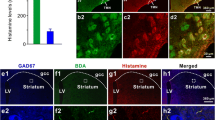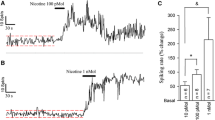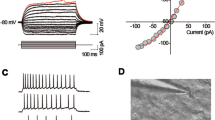Abstract.
To investigate whether histaminergic neurons influence the activity of cholinergic neurons, the ventral striatum was superfused through a push-pull cannula and the release of endogenous acetylcholine was determined in the superfusate. Local inhibition of histamine synthesis by superfusion with α-fluoromethylhistidine (FMH) gradually decreased the release rate of acetylcholine. Superfusion with histamine increased the release of acetylcholine. The releasing effect of histamine was greatly inhibited when the striatum was simultaneously superfused with the D2/D3 agonist quinpirole and the D1 antagonist (±)-7-bromo-1-(fluoresceinylthioureido)phenyl-8-hydroxy-3-methyl-2,3,4,5-tetrahydro-1H-3-benzapine (SKF 83566). The effect of histamine on acetylcholine release was abolished by the GABAA receptor antagonist bicuculline. Superfusion with the H3 receptor agonists imetit or immepip increased acetylcholine release rate in the striatum. The releasing effects of the two H3 agonists were FMH resistant, while superfusion with quinpirole and SKF 83566 abolished the H3 receptor agonist-induced acetylcholine release. Superfusion with the H3 receptor antagonist thioperamide enhanced acetylcholine release rate. The releasing effect of thioperamide was abolished after inhibition of histamine synthesis by FMH. The release of acetylcholine by thioperamide was also abolished on simultaneous superfusion with quinpirole and SKF 83566.
The findings show that, in the striatum, the activity of cholinergic neurons is permanently modulated by neighbouring histaminergic nerve terminals and axons. The release of acetylcholine is also permanently inhibited by neighbouring GABAergic neurons. The enhanced release of acetylcholine by the H3 receptor agonists imetit and immepip is due to stimulation of H3 heteroreceptors, while the increase of acetylcholine release by the H3 receptor antagonist thioperamide is elicited via blockade of H3 autoreceptors. Histamine released from histaminergic nerve terminals increases the release of acetylcholine in part by inhibition of dopamine release which, in turn, decreases GABAergic transmission. A dopamine-independent way seems also to be involved in the histamine-evoked acetylcholine release.
Similar content being viewed by others
Author information
Authors and Affiliations
Additional information
Electronic Publication
Rights and permissions
About this article
Cite this article
Prast, H., Tran, M., Fischer, H. et al. Histaminergic neurons modulate acetylcholine release in the ventral striatum: role of H3 histamine receptors. Naunyn-Schmiedeberg's Arch Pharmacol 360, 558–564 (1999). https://doi.org/10.1007/s002109900097
Received:
Accepted:
Issue Date:
DOI: https://doi.org/10.1007/s002109900097




